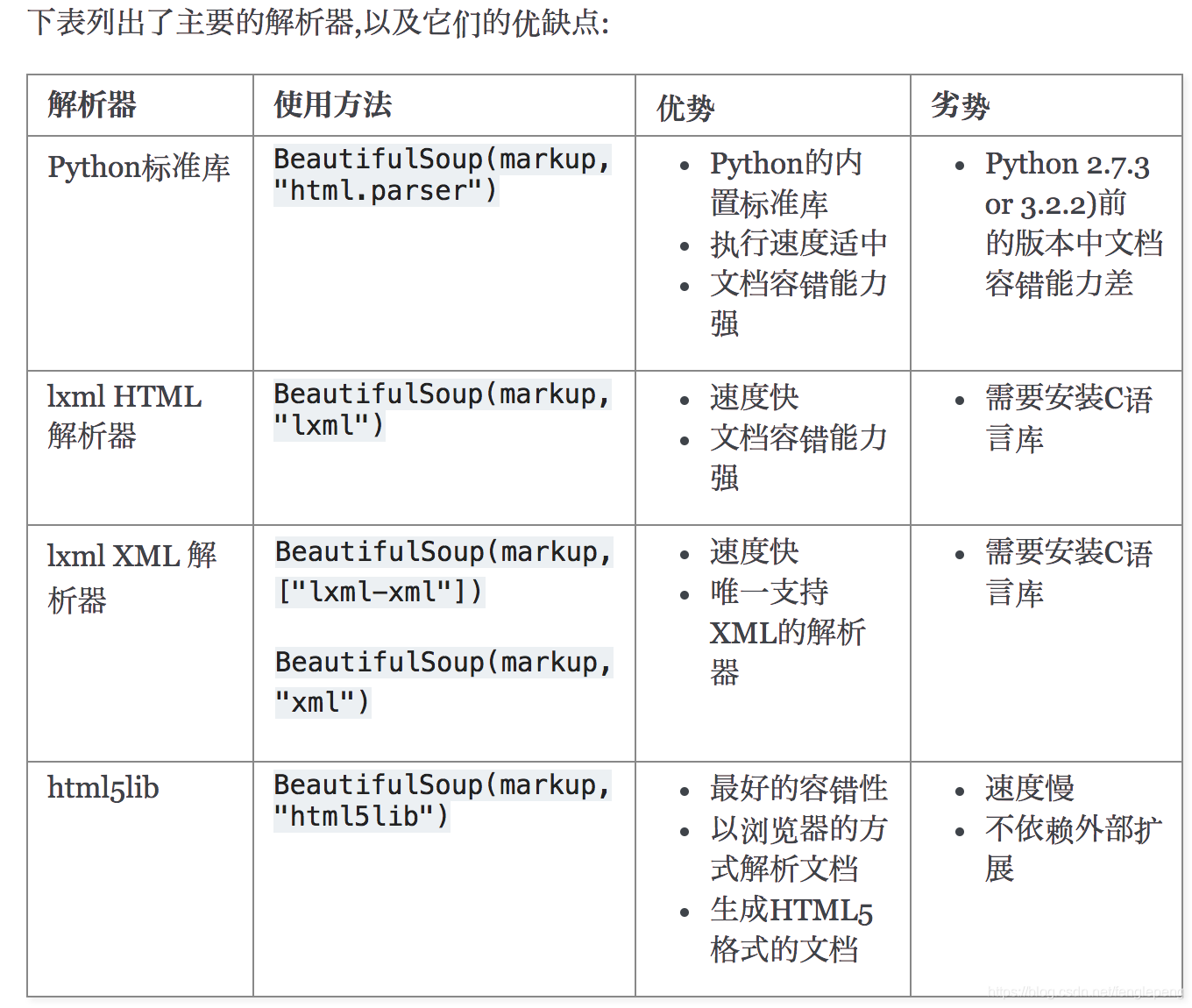简单来说,Beautiful Soup是python的一个库,最主要的功能是从网页抓取数据。官方解释如下:官网文档
Beautiful Soup提供一些简单的、python式的函数用来处理导航、搜索、修改分析树等功能。
它是一个工具箱,通过解析文档为用户提供需要抓取的数据,因为简单,所以不需要多少代码就可以写出一个完整的应用程序。
安装
pip3 install beautifulsoup4
解析器
Beautiful Soup支持Python标准库中的HTML解析器,还支持一些第三方的解析器,如果我们不安装它,则 Python 会使用 Python默认的解析器,lxml 解析器更加强大,速度更快,推荐安装。
pip3 install lxml
另一个可供选择的解析器是纯Python实现的 html5lib , html5lib的解析方式与浏览器相同,可以选择下列方法来安装html5lib:
pip install html5lib
解析器对比

BeautifulSoup是一个模块,该模块用于接收一个HTML或XML字符串,然后将其进行格式化,之后遍可以使用他提供的方法进行快速查找指定元素,从而使得在HTML或XML中查找指定元素变得简单。
用法
# 简单示例
from bs4 import BeautifulSouphtml_doc = """
<html><head><title>The Dormouse's story</title></head>
<body>
asdf<div class="title"><b>The Dormouse's story总共</b><h1>f</h1></div>
<div class="story">Once upon a time there were three little sisters; and their names were<a class="sister0" id="link1">Els<span>f</span>ie</a>,<a href="http://example.com/lacie" class="sister" id="link2">Lacie</a> and<a href="http://example.com/tillie" class="sister" id="link3">Tillie</a>;
and they lived at the bottom of a well.</div>
ad<br/>sf
<p class="story">...</p>
</body>
</html>
"""soup = BeautifulSoup(html_doc, features="lxml")
tag1 = soup.find(name='a') # 找到第一个a标签
tag2 = soup.find_all(name='a') # 找到所有的a标签
tag3 = soup.select('#link2') # 找到id=link2的标签
find(name, attrs, recursive, text, **kwargs)
# name参数,查找所有名字为name的tag,字符串对象被忽略。
soup.find_all('title') # keyword参数,如果一个指定名字的参数不是搜索内置的参数名,搜索时会把该参数当作指定名字tag的属性来搜索。
soup.find_all(id='link2')# 如果多个指定名字的参数可以同时过滤tag的多个属性:
soup.find_all(href=re.compile('elsie'),id='link1') # 有些tag属性在搜索不能使用,比如HTML5中的data*属性,但是可以通过find_all()的attrs参数定义一个字典来搜索:
data_soup.find_all(attrs={'data-foo':'value'})# recursive参数
如果指向搜索tag的直接子节点,可以使用参数recursive=False。# limit参数
可以用来限制返回结果的数量# text 参数
通过 text 参数可以搜搜文档中的字符串内容,与 name 参数的可选值一样, text 参数接受 字符串 , 正则表达式 , 列表
使用示例:
- text,标签内容
print(soup.text)
print(soup.get_text())
# 两种方式都可以返回获取的所有文本
- name,标签名称
tag = soup.find('a')
name = tag.name # 获取标签名称
print(name)
tag.name = 'span' # 设置标签名称
print(soup)
- attrs,标签属性
tag = soup.find('a')
attrs = tag.attrs # 获取标签属性
print(attrs)
tag.attrs = {'ik':123} # 设置标签属性
tag.attrs['id'] = 'iiiii' # 设置标签属性
print(soup)
- children,所有子标签
body = soup.find('body')
v = body.children
- descendants,所有子子孙孙标签
body = soup.find('body')
v = body.descendants
- clear,将标签的所有子标签全部清空(保留标签名)
tag = soup.find('body')
tag.clear()
print(soup)
- decompose,递归的删除所有的标签
body = soup.find('body')
body.decompose()
print(soup)
- extract,递归的删除所有的标签,并获取删除的标签
body = soup.find('body')
v = body.extract()
print(soup)
- decode,转换为字符串(含当前标签);decode_contents(不含当前标签)
body = soup.find('body')
v = body.decode()
v = body.decode_contents()
print(v)
- encode,转换为字节(含当前标签);encode_contents(不含当前标签)
body = soup.find('body')
v = body.encode()
v = body.encode_contents()
print(v)
- find,获取匹配的第一个标签
tag = soup.find('a')
print(tag)
tag = soup.find(name='a', attrs={'class': 'sister'}, recursive=True, text='Lacie')
tag = soup.find(name='a', class_='sister', recursive=True, text='Lacie')
print(tag)
- find_all,获取匹配的所有标签
tags = soup.find_all('a')
print(tags)
tags = soup.find_all('a',limit=1)
print(tags)
tags = soup.find_all(name='a', attrs={'class': 'sister'}, recursive=True, text='Lacie')
# tags = soup.find(name='a', class_='sister', recursive=True, text='Lacie')
print(tags)# ####### 列表 #######
# v = soup.find_all(name=['a','div'])
# print(v)# v = soup.find_all(class_=['sister0', 'sister'])
# print(v)# v = soup.find_all(text=['Tillie'])
# print(v, type(v[0]))# v = soup.find_all(id=['link1','link2'])
# print(v)# v = soup.find_all(href=['link1','link2'])
# print(v)# ####### 正则 #######
import re
# rep = re.compile('p')
# rep = re.compile('^p')
# v = soup.find_all(name=rep)
# print(v)# rep = re.compile('sister.*')
# v = soup.find_all(class_=rep)
# print(v)# rep = re.compile('http://www.oldboy.com/static/.*')
# v = soup.find_all(href=rep)
# print(v)# ####### 方法筛选 #######
# def func(tag):
# return tag.has_attr('class') and tag.has_attr('id')
# v = soup.find_all(name=func)
# print(v)# ####### get,获取标签属性
# tag = soup.find('a')
# v = tag.get('id')
# print(v)
- has_attr,检查标签是否具有该属性
tag = soup.find('a')
v = tag.has_attr('id')
print(v)
- get_text,获取标签内部文本内容
tag = soup.find('a')
v = tag.get_text('id')
print(v)
- index,检查标签在某标签中的索引位置
tag = soup.find('body')
v = tag.index(tag.find('div'))
print(v)tag = soup.find('body')
for i,v in enumerate(tag):print(i,v)
- is_empty_element,是否是空标签(是否可以是空)或者自闭合标签,
判断是否是如下标签:’br’ , ‘hr’, ‘input’, ‘img’, ‘meta’,’spacer’, ‘link’, ‘frame’, ‘base’
tag = soup.find('br')
v = tag.is_empty_element
print(v)
- 当前的关联标签
soup.next
soup.next_element
soup.next_elements
soup.next_sibling
soup.next_siblings
tag.previous
tag.previous_element
tag.previous_elements
tag.previous_sibling
tag.previous_siblings
tag.parent
tag.parents
- 查找某标签的关联标签
# tag.find_next(...)
# tag.find_all_next(...)
# tag.find_next_sibling(...)
# tag.find_next_siblings(...)# tag.find_previous(...)
# tag.find_all_previous(...)
# tag.find_previous_sibling(...)
# tag.find_previous_siblings(...)# tag.find_parent(...)
# tag.find_parents(...)# 参数同find_all
- select,select_one, CSS选择器
soup.select("title")
soup.select("p nth-of-type(3)")
soup.select("body a")
soup.select("html head title")
tag = soup.select("span,a")
soup.select("head > title")
soup.select("p > a")
soup.select("p > a:nth-of-type(2)")
soup.select("p > #link1")
soup.select("body > a")
soup.select("#link1 ~ .sister")
soup.select("#link1 + .sister")
soup.select(".sister")
soup.select("[class~=sister]")
soup.select("#link1")
soup.select("a#link2")
soup.select('a[href]')
soup.select('a[href="http://example.com/elsie"]')
soup.select('a[href^="http://example.com/"]')
soup.select('a[href$="tillie"]')
soup.select('a[href*=".com/el"]')from bs4.element import Tagdef default_candidate_generator(tag):for child in tag.descendants:if not isinstance(child, Tag):continueif not child.has_attr('href'):continueyield childtags = soup.find('body').select("a", _candidate_generator=default_candidate_generator)
print(type(tags), tags)from bs4.element import Tag
def default_candidate_generator(tag):for child in tag.descendants:if not isinstance(child, Tag):continueif not child.has_attr('href'):continueyield childtags = soup.find('body').select("a", _candidate_generator=default_candidate_generator, limit=1)
print(type(tags), tags)
- 标签的内容
# tag = soup.find('span')
# print(tag.string) # 获取
# tag.string = 'new content' # 设置
# print(soup)# tag = soup.find('body')
# print(tag.string)
# tag.string = 'xxx'
# print(soup)# tag = soup.find('body')
# v = tag.stripped_strings # 递归内部获取所有标签的文本
# print(v)
- append在当前标签内部追加一个标签
# tag = soup.find('body')
# tag.append(soup.find('a'))
# print(soup)
#
# from bs4.element import Tag
# obj = Tag(name='i',attrs={'id': 'it'})
# obj.string = '我是一个新来的'
# tag = soup.find('body')
# tag.append(obj)
# print(soup)
- insert在当前标签内部指定位置插入一个标签
# from bs4.element import Tag
# obj = Tag(name='i', attrs={'id': 'it'})
# obj.string = '我是一个新来的'
# tag = soup.find('body')
# tag.insert(2, obj)
# print(soup)
- insert_after,insert_before 在当前标签后面或前面插入
# from bs4.element import Tag
# obj = Tag(name='i', attrs={'id': 'it'})
# obj.string = '我是一个新来的'
# tag = soup.find('body')
# # tag.insert_before(obj)
# tag.insert_after(obj)
# print(soup)
- replace_with 在当前标签替换为指定标签
# from bs4.element import Tag
# obj = Tag(name='i', attrs={'id': 'it'})
# obj.string = '我是一个新来的'
# tag = soup.find('div')
# tag.replace_with(obj)
# print(soup)
- 创建标签之间的关系
# tag = soup.find('div')
# a = soup.find('a')
# tag.setup(previous_sibling=a)
# print(tag.previous_sibling)
- wrap,将指定标签把当前标签包裹起来
# from bs4.element import Tag
# obj1 = Tag(name='div', attrs={'id': 'it'})
# obj1.string = '我是一个新来的'
#
# tag = soup.find('a')
# v = tag.wrap(obj1)
# print(soup)# tag = soup.find('a')
# v = tag.wrap(soup.find('p'))
# print(soup)
- unwrap,去掉当前标签,将保留其包裹的标签
# tag = soup.find('a')
# v = tag.unwrap()
# print(soup)
更多参数官方:http://beautifulsoup.readthedocs.io/zh_CN/v4.4.0/


Linux下PS1、PS2、PS3、PS4使用详解)



)




)
-http通信demo)






